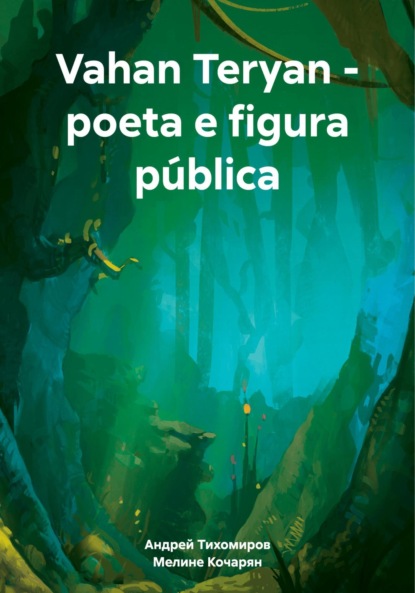
Полная версия:
Мелине Кочарян Vahan Teryan – poet and public figure
- + Увеличить шрифт
- - Уменьшить шрифт

Андрей Тихомиров, Мелине Кочарян
Vahan Teryan – poet and public figure
Armenia's ties with Russia
For many centuries, Armenia has either lost its independence and fallen under the rule of foreign invaders, or regained its independence. Its boundaries were changing. The constant pogroms and persecution of Armenians have led to the fact that some regions of Armenia have been depopulated. The remains of Armenian cities, fortresses, and irrigation structures have been preserved throughout the Armenian Highlands. In the first third of the 19th century, according to the Treaty of Turkmanchay, Eastern Armenia became part of Russia. The Armenian region was formed from the Erivan and Nakhichevan khanates. In 1828-1829 . As a result of the Russian-Turkish war, the Armenian cities of Kars, Ardagan, Bayazet, Erzurum were ceded to Russia, which, however, were returned to Turkey under the Adrianople Peace Treaty (1829). In the first three decades of the XIX century, about 150 thousand Armenians migrated from Iran and Turkey to Eastern Armenia. The act of Armenia's annexation to Russia had a huge progressive significance. He predetermined the entire further course of Armenia's socio-economic and political development. The people of Eastern Armenia were forever freed from the threat of physical destruction and embarked on the path of progressive development, linking their fate with the fate of the Russian people. The writer-educator X. Russian Russians, revolutionary democrat M. Nalbandian, national poet O. Tumanyan and other Armenian enlighteners, expressing the aspirations of the masses, saw in the Russian people, in familiarization with Russian culture, with the Russian advanced social movement, the salvation of their people and the possibility of their economic and cultural development.
However, Armenia, being a backward suburb of tsarist Russia, had an extremely underdeveloped economy. The industry was represented by small, semi-industrial enterprises, mainly processing agricultural raw materials. The only large enterprises were copper mines and copper smelters in Alaverdi and Zangezur. A significant part of the industrial enterprises were in the hands of foreign capital. Primitive technology prevailed in agriculture. Animal husbandry was extensive.
Transcaucasia's entry onto the path of capitalist development strengthened its economic ties with Russia, which, in turn, even more closely linked the national liberation movement of the peoples of the region with the Russian workers' movement.
The best sons of the Armenian people linked the fate of their people with the fate of Russia. These are figures of the social movement such as Isaac Lalayants, Bogdan Knunyants, Stepan Shaumyan, Suren Spandaryan, Alexander Myasnikyan and others. During the First World War (1914-1918) in Western Armenia, the Turkish government pursued a policy of genocide against the Armenian people. As a result, more than 1.5 million Armenians were killed, about 300,000 refugees found refuge in Russia, and some settled in the Middle East, Europe, and America.
The creative ideas of the Soviet leadership to create a free Armenia were reflected in the decree of the Council of People's Commissars "On Turkish Armenia" (December 29, 1917). However, the intervention of the German-Turkish bloc in Transcaucasia, the policy of the imperialist powers in the Middle East prevented the implementation of this decree. The anti-Soviet policy received full support from the imperialists of the United States and the Entente, who set the task of turning the territory of Armenia into their colony and an anti-Soviet military foothold. However, the workers and peasants of Armenia rose up to fight against foreign henchmen. In September 1919, the first illegal meeting of the Communist organizations of Armenia was held in Yerevan, and in January 1920, the first (illegal) conference of communist organizations, which completed the process of unification and consolidation of the party organizations of Armenia. The communist poet Vahan Teryan takes an active part in these revolutionary processes.
Thanks to the fraternal help of the Russian people, the working people of Armenia were able to finally defeat the forces of the interventionists and the nationalist counterrevolution and establish Soviet power in Armenia on November 29, 1920. V. I. Lenin warmly welcomed "Soviet Armenia liberated from the yoke of imperialism."
During the years of their domination (1918-1920), nationalists and foreign occupiers led the country to an economic and political catastrophe. Arbitrariness and outrages, the oppression of capital, semi-serfdom forms of labor put the workers and peasants of Armenia in an extremely difficult situation.
With the establishment of Soviet power in Armenia, the restoration of the republic's economy began. With the fraternal help of the peoples of other Soviet republics, by 1928, industrial production reached the level of 1913, and agricultural production exceeded it.
During the years of the pre-war five-year plans, 25 large industrial enterprises were built and put into operation in the republic, non-ferrous metallurgy was expanded, enterprises of the chemical, light, and food industries were created.
Illiteracy was eliminated in the republic, and qualified national cadres of the working class and intelligentsia were created. The network of scientific and cultural institutions has expanded. Soviet Armenian literature and art developed.
The Great Patriotic War of 1941-1945 was the greatest test of the Soviet socialist system and the friendship of the Soviet peoples. Thousands of residents of the republic stood up for the Motherland. About 70 thousand Armenian soldiers were awarded military orders and medals of the USSR. 103 people were awarded the high title of Hero of the Soviet Union.
380 thousand Armenian workers were awarded government awards for their valiant labor during the Great Patriotic War.
In the post-war period, there was a significant rise in the Armenian economy.
Armenia was awarded the Order of Lenin in December 1958 for increasing the production of agricultural products, fulfilling and exceeding the plan to sell raw cotton, sugar beet, grain, meat, milk and wool to the state. For the successes achieved by the Armenian workers in economic and cultural construction, the republic was awarded the Second Order of Lenin (October 1968), the Order of the October Revolution (November 1970), the Order of Friendship of Peoples (December 1972), the Order of Lenin (October 1978).
During the years of Soviet rule, a broad healthcare system was created in Armenia, providing the population of the republic with all types of medical care. Socio-economic transformations have put an end to epidemic diseases. Compared to 1913, the number of hospital beds has increased by more than 100 times. In 1980, there were 171 hospital facilities with 26 thousand hospital beds. In 1980, 11.1 thousand doctors worked in the republic (in 1913 there were only 73 doctors), the number of secondary medical personnel was 26.6 thousand people. New hospital facilities, dispensaries, polyclinics have been put into operation, and the network of resorts and rest homes has expanded.
Hundreds of thousands of people were treated and rested annually in 89 sanatoriums, rest homes, boarding houses and tourist bases. The resorts of Arzli, Jermuk, Dilijan, Sevan, etc. are known far beyond the borders of the republic.
Sports were widely developed. By the beginning of 1981, there were 24 stadiums in the republic. 89 football fields and 979 volleyball, basketball and tennis courts. The total number of physical education students is 720 thousand people. Since 1970, the republican stadium "Hrazdan" has been operating, accommodating up to 75 thousand spectators.
The center of the development of scientific thought in the republic was the Academy of Sciences of the Armenian SSR, founded in 1943. As part of the Academy in 1980, it worked
88 academicians and corresponding members. There were hundreds of scientific institutions of various profiles in the republic. In Soviet Armenia, such problems of modern science as astrophysics, radio engineering, electronics, cybernetics, biochemistry and physiology, biophysics, bionics, etc. were developed. The Byurakan Astrophysical Observatory was world famous.
Конец ознакомительного фрагмента.
Текст предоставлен ООО «Литрес».
Прочитайте эту книгу целиком, купив полную легальную версию на Литрес.
Безопасно оплатить книгу можно банковской картой Visa, MasterCard, Maestro, со счета мобильного телефона, с платежного терминала, в салоне МТС или Связной, через PayPal, WebMoney, Яндекс.Деньги, QIWI Кошелек, бонусными картами или другим удобным Вам способом.





